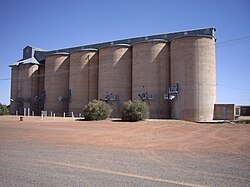
Grains may be lost in the pre-harvest, harvest, and post-harvest stages. Pre-harvest losses occur before the process of harvesting begins, and may be due to insects, weeds, and rusts. Harvest losses occur between the beginning and completion of harvesting, and are primarily caused by losses due to shattering. Post-harvest losses occur between harvest and the moment of human consumption. They include on-farm losses, such as when grain is threshed, winnowed, and dried. Other on-farm losses include inadequate harvesting time, climatic conditions, practices applied at harvest and handling, and challenges in marketing produce. Significant losses are caused by inadequate storage conditions as well as decisions made at earlier stages of the supply chain, including transportation, storage, and processing, which predispose products to a shorter shelf life.[1]
Important in many developing countries, particularly in Africa, are on-farm losses during storage, when the grain is being stored for auto-consumption or while the farmer awaits a selling opportunity or a rise in prices.
- ^ FAO (2019). In brief: The State of Food and Agriculture 2019. Moving forward on food loss and waste reduction. Rome. p. 12.
{{cite book}}: CS1 maint: location missing publisher (link)